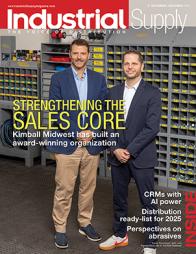Surviving Amazon Business

by Dick Friedman
Amazon Business (AB) is receiving much publicity as THE threat to many fastener, tool, industrial and MRO distributors. But AB is not the main, nor the only, threat. The real threats are the business models that AB is perfecting, and that others are copying, including Alibaba, eBay Business Supply and other “alternate channels of distribution.”
In one model, the e-commerce site is owned by the entity that owns the inventory stored in its warehouse. In the other model, the e-commerce site is a “marketplace” on which qualified sellers list products for sale, and the sellers ship them; some owners of marketplaces also store and ship products that sellers provide. Both kinds of sellers have no sales or order entry people; some have no warehouse people or trucks. AB is a combination of both models, with the latter being much larger, and offers to store and ship (fulfillment). Among those using both models are manufacturers that sell via traditional distributors and also use alias e-commerce sites to sell directly to end users.
Other aspects of the low-cost, low-price models include: Automated storage and fulfillment (high storage density and rate of warehouse productivity); Outsourced warehouse (in some cases sellers store products in 3PLs or fulfillment centers, paying only for the space and services used); No computer (they use “cloud” computing – remote computer and software, paying only for resources used); Outsourced shipping (no company trucks or drivers).
The alternate channels tend to focus on selling fast-moving commodities (such as abrasives) at low prices, so distributors that sell commodities could suffer from reduced gross margin revenue that is inadequate to cover overhead. But some alternate channels specialize in slower-moving, non-commodity products (such as air-powered tools), impacting distributors that specialize in non-commodities and squeezing distributors that sell a broad line of both commodities and non- commodities.
Many traditional distributors are finding it almost impossible to profitably compete with the alternate channels’ low prices and logistics capabilities, and are wondering what to do. This article contains some ideas for investigating different e-commerce strategies, and some for thriving regardless of e-commerce.
But whatever strategy is pursued, a distributor needs real-time ERP tracking of the quantity of each item in each storage location, including on receiving docks (inside and outside), and on the floor. The ERP system must also track the quantity available to sell, not just on hand, and a distributor using e-commerce must have enough stock on hand to avoid short-ships to both traditional and e-commerce customers. Also required is a very low rate of mistakes in the warehouse and by drivers.
E-commerce Capability
Distributors that do not have a true e-commerce site and are worried about the impact of AB and other alternate channels, as well as competitors with their own e-commerce sites, should investigate whether to establish their own e-commerce capability. Start with an estimate of product and customer growth/change, then use that estimate to determine if e-commerce software or a marketplace would accommodate the future business mix. If so, the next step is to determine the source and cost of data and pictures that would appear on a site. Also estimate the cost of marketing to promote e-commerce, and any charges you might incur from providers of e-commerce software and marketplaces. “Guesstimating” is the word that describes estimating the increase in sales from using e-commerce.
But the decision is not all about money, so it’s important to contact a few users of the software and services about their experiences, then create a list of non-financial factors (such as the time to implement). Finally, calculate life-cycle savings less costs, then use dollars and non-dollars to determine whether to obtain e-commerce software or a service, if either.
Independent E-commerce Site
Distributors wondering whether to sell on a marketplace (such as AB) should investigate each one by first going through most of the steps mentioned in E-commerce Capability, above, skipping ones that do not apply (such as the cost of owning software). Then study the data needed for being approved for selling, rules about types of products/services that can be sold, rules about rating seller performance and customer service, and rules about buyer – customer – eligibility. Also study a marketplace’s functions and features. Next, guesstimate the expected extra sales from using a marketplace. Determine a marketplace’s fee and charges structure, and use that to estimate annual sales charges and determine how a seller gets paid. If a site sells ads that would be bought, estimate those costs.
As with the decision about an owned e-commerce capability, this decision is not all about money. Contact users of the marketplaces about their experiences and revise the list of non-financial factors previously created. Finally, calculate life-cycle savings less costs, and use dollars and non-dollars to determine whether to use a particular marketplace.
Ideas For Thriving Regardless of E-Commerce
There are numerous ideas for growing a business, and they can be grouped into the following:
- “Helping-hand” free services to customers (such as marketing assistance to small customers)
- Chargeable customer services (Distributor-Managed Inventory – DMI – where the distributor provides product without the customer ordering any)
- Value-added services, for a fee (For example, if a customer is buying two products that they then assemble, offer to do the assembling)
- Consider obtaining new lines, related and unrelated to current lines (such as high-tech tools)
- Budget for aggressive marketing, not just selling
- Customer loyalty programs (Such as free or discounted trips/cruises, or free merchandise, to customers whose sales increase at least Y% and $X)
- Referral programs (For example, cash or merchandise rewards to non-government customers who provide information that results in acquiring a new customer).
Already Have An E-commerce Site?
Distributors that have a true, integrated e-commerce capability, but are not getting as much revenue as expected, or would like to develop new revenue streams can use the steps above to determine whether to use a marketplace, and determine actions to take to obtain new business regardless of alternate channels of distribution (actions to thrive).
Although the threats from e-commerce will continue growing, there are e-commerce strategies that traditional distributors can explore, and should do so as soon as possible.
Dick Friedman has written “The Distributors Guide To Surviving Amazon Business While Thriving.” For a free copy, visit www.GenBusCon.com, or call (847) 256-1410.
 For more than 40 years, Dick Friedman has been helping fastener, tool, industrial and MRO distributors prevent inventory shortages and warehouse mistakes that lose sales and customers; and helping them select ERP, e-commerce and WMS systems, while avoiding the problems and pitfalls. Dick does not sell systems, software or warehouse technology. He is a certified management consultant and is objective and unbiased. Reach him at (847) 256-1410 for a free consultation, or visit www.GenBusCon.com for more information or to send email.
For more than 40 years, Dick Friedman has been helping fastener, tool, industrial and MRO distributors prevent inventory shortages and warehouse mistakes that lose sales and customers; and helping them select ERP, e-commerce and WMS systems, while avoiding the problems and pitfalls. Dick does not sell systems, software or warehouse technology. He is a certified management consultant and is objective and unbiased. Reach him at (847) 256-1410 for a free consultation, or visit www.GenBusCon.com for more information or to send email.
This article originally appeared in the May/June. 2017 issue of Industrial Supply magazine. Copyright 2017, Direct Business Media.











